DONA NANKA, India (AFP) - Through his bloodshot, ruined eyes, ten-year-old Roshan Singh struggles to read his favourite comic book before readying for school in this remote and desolate village along the Indian-Pakistan border.
Singh, whom doctors say will soon be blind, has always drunk ground water drawn from communal handpumps that experts say is highly toxic and responsible for maiming scores of residents young and old.
"I fear the worst all the time. My parents also worry for me a lot," Singh told Agence France-Presse, nervously tugging at his school shirt in Dona Nanka village in Punjab state.
Since coming to power in May, nationalist Prime Minister Narendra Modi has pledged to clean up the beloved, sacred Ganges river, describing its pollution as a national shame.
But in India's north-west frontier, where another river is heavily contaminated with lead, uranium and other metals, residents have long been left to fend for themselves.
"Wheelchairs have become a way of life here. This is our destiny," said 65-year-old farmer Maun Singh, sitting next to two of his sons, aged 25 and 18, who have gone blind. His village and several others are clustered around a creek at the end of the Sutlej river. The Sutlej roars down from the Himalayas through India and into neighbouring Pakistan - before turning back into India again.
Experts suspect Indian factories and Pakistan tanneries pour untreated waste into the river where it eventually gathers and settles in its tranquil tailend, seeping into the ground water.
Although scientists are unsure whether India or Pakistan, or both, are to blame for the contamination, the consequences are staggering.
Blindness, deformed limbs, premature greying of hair, learning disabilities and skin diseases are common among the 1,200 residents, while wheelchairs can be seen everywhere. "It is not just one student, I have seen so many others forced to quit school because of blindness or some other problem," said local school principal Lovjeet Singh, adding that 108 out of 270 of his students are suffering from some disease or deformity.
For years, impoverished farmers and their families have relied on wells, ponds, irrigation reservoirs and handpumps for their water for cooking, cleaning and drinking.
Mr Bhajan Singh, paralysed from the waist down since he was six months old, remembers government officials posting warnings on village walls in 2010 that read "water in this village is unfit for human consumption".
"They put up water treatment plants in some villages but we still don't have one," said 30-year-old Mr Singh from neighbouring Teja Rohela village. "I hope they act fast because the poisoned water is ruining everything," Mr Singh said from his wheelchair.
Contamination of water supplies is common in India and other developing countries where rapid industrialisation often runs rough shod over environmental concerns.
But doctor Pritpal Singh said the problems facing villagers of Punjab's Malwa region are particularly shocking. Blood samples taken in 2010 from 149 children showed high levels of heavy metals, said Dr Singh, who has been researching and treating villagers for the last 12 years.
"We had to send the samples to Germany because labs in India are not equipped to conduct such tests," he told AFP at his clinic in neighbouring Faridkot city.
"The results were shocking. We had expected some exposure to mercury or arsenic but 88 percent of the samples showed high levels of uranium and lead toxicity in these children."
Tests conducted on groundwater in 2012 in four districts by the state-run Bhabha Atomic Research Center showed 42 percent of the samples had concentrations of uranium above permissible limits for drinking water.
Punjab has no uranium mines but local lawmaker Bhagwant Mann accuses tanneries in Pakistan and heavy industries in Punjab of making the groundwater toxic.
"Stringent laws should be framed to stop factories from dumping their untreated waste into rivers. I see this as the only solution," Mr Mann said.
Some experts also blame the Green Revolution in the 1960s that saw a doubling of farm yields in Punjab, known as the bread basket of India, but also increased soil and water contamination through hiked pesticide use.
Whoever is at fault, Mr Surjit Singh Rakhra, state minister for water supply and sanitation, said the government was working hard to halt the health problems, including partnering with the World Bank to find solutions.
"We have identified the villages where heavy metals have been found in water. We will install water treatment plants in all such villages sooner than later, 100 per cent," Mr Rakhra told AFP.
The promises have however come too late for Mr Maun Singh, left with two blind sons to care for. But the impoverished farmer holds out hope that the government will eventually halt the area's growing list of disabled and diseased residents.
"My sons mean the world to me. And my world has been plunged into darkness," he said. "But at least our new generation will get to live a better life, that's our only ray of hope."

